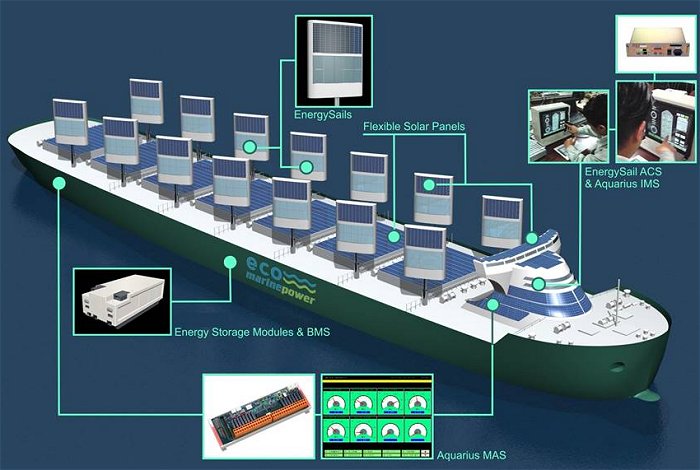
Japan’s Eco Marine Power is preparing for sea trials next year of a rigid sail and solar power system designed for use on bulk carriers.
Shipping goods and materials between ports is fuel-thirsty and emissions intensive work. According to the European Commission, maritime transport is responsible for a billion tonnes of carbon dioxide emissions annually and accounts for 2.5% of global greenhouse gas emissions.
Emissions from the sector are forecast to increase between 50% and 250% by 2050 and shipping could be responsible for 17% of global CO2 emissions that year if action is not taken.
Part of the solution may lie in old technology with a new twist – sticking rigid sails and solar panels on huge freighters. Fukuoka, Japan-based Eco Marine Power is about to put its Aquarius MRE solution to the test under real-world conditions.
Aquarius MRE consists of rigid sails, solar panels designed for a marine environment, energy storage modules and associated systems. As well as on decks, solar panels can also be integrated on EMP’s sail product, EnergySail. The company says EnergySail can be used on a wide variety of ships, from huge bulk ore carriers to naval and coastguard patrol ships.
The sails are controlled by a computer system that automatically position the EnergySails to maximise harvesting of available wind or solar power resources. EnergySail is automatically lowered by the computer control system in the event of particularly strong winds to avoid damage.
Prior to the sea trials next year, a feasibility study is currently underway involving carriers including the 229 metre-long Belgrano, Nord Gemini (also 229m) and Bulk Chile (190m) to determine the equipment that will be required.
It won’t be the first time that rigid sails have been used on carriers – in the 1980’s, some Japanese ships were fitted with rigid sails in response to an oil crisis. When the crisis passed and oil prices plummeted, they were no longer viable.
Combining sails and solar power is also not a new idea.
“Ideas and concepts that combine sails with solar power probably pre-date the 1990’s however to date, no combined wind power and solar power system that incorporates rigid sails has been deployed on large commercial ocean-going ships. But this situation is about to change,” says EMP.
The company believes 1,000 tonnes or more of bunker fuel could be saved and 3,000 tonnes of CO2 emissions avoided annually by using the Aquarius MRE system on a large ship.

 RSS - Posts
RSS - Posts



Speak Your Mind